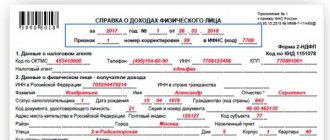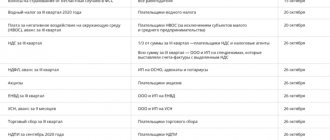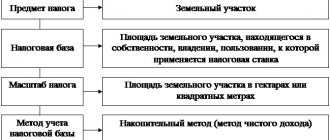Who should not submit the calculation?
If an organization does not have fixed assets recognized as objects of taxation, it is not necessary to report property taxes. The grounds for this are clause 1 of Art. 373, art. 374, paragraph 1, art. 386 of the Tax Code of the Russian Federation, letter of the Ministry of Finance of Russia dated September 23, 2011 No. 03-05-05-01/74.
There is also no need to submit settlements in relation to preferential property related to oil production at offshore fields (paragraph 2, paragraph 1, article 386, paragraph 24, article 381 of the Tax Code of the Russian Federation). Include the remaining property that is subject to taxation in the calculation. Read more in the article on what property is subject to tax. Even if other benefits apply to this property. For example, movable property that belongs to 3–10 depreciation groups must be included in the calculation. Even if it was acquired after January 1, 2013 (letter of the Federal Tax Service of Russia dated December 17, 2014 No. BS-4-11/26159).
And of course, the calculation of advance payments for property tax (as well as the declaration for this tax) is not submitted by entrepreneurs and citizens. They do not pay such a tax in principle (clause 1 of Article 373 of the Tax Code of the Russian Federation).
Situation: who must submit calculations of advance payments for property tax - the founder of the trust management or the trustee?
Founder of trust management.
Taxpayers are required to submit tax calculations (subclause 4, clause 1, article 23, clause 1, article 386 of the Tax Code of the Russian Federation). And for objects transferred to trust management, the payer of the property tax is the founder of the trust management (Article 378 of the Tax Code of the Russian Federation). That is, an organization that has transferred its property to a manager. Thus, it is she who must prepare and submit tax reports on property tax. A similar point of view is reflected in the letter of the Ministry of Finance of Russia dated September 23, 2008 No. 03-05-05-01/58, paragraphs 3–4 of paragraph 3 of the letter of the Ministry of Finance of Russia dated August 2, 2005 No. 07-05-06/216.
Situation: is it necessary to submit calculations of advance payments for property tax if the residual value of fixed assets is zero? The organization applies a general taxation system.
Yes need.
Calculations of advance payments for property tax must be submitted by all payers of this tax (Article 386 of the Tax Code of the Russian Federation). And these are all organizations that have fixed assets that are taxed (clause 1 of Article 373, Article 374 of the Tax Code of the Russian Federation). The amount of the residual value of the property is not important - there is no such restriction in the Tax Code of the Russian Federation.
If the residual value of fixed assets recognized as an object of taxation is zero, the tax base and the amount of tax that must be indicated in the calculations will be equal to zero. However, the organization is required to submit estimates of advance property tax payments. This is confirmed by letter of the Federal Tax Service of Russia dated February 8, 2010 No. 3-3-05/128.
An organization may also have real estate objects, the tax base for which is their cadastral value. The amount of the advance payment for property tax on such objects does not depend on their residual value. This means that in this case the organization must also submit calculations of advance payments for property tax.
Profit reports
The codification of “profitable” reporting is somewhat different from the quarterly forms. Thus, the profit declaration is filled out with an accrual total from the beginning of the year.
So, define ciphers like this:
- for the first quarter, indicate “21”;
- tax period code 31 is a report for the 1st half of the year;
- tax period 33 - which quarter is this? This is not a quarter in profit reporting, this is information for the first 9 months of the reporting year;
- tax period code 34 - annual information from January to December.
If a company submits profit reports monthly, then a completely different codification is applied. For example, 35 is the first month of the year, 36 is the second, 37 is the third, and so on.
The key rules for filling out income tax reporting are regulated in Order of the Federal Tax Service of Russia dated October 19, 2016 No. ММВ-7-3/ [email protected]
Tax period 50 is used in the report if the company was in the process of reorganization or liquidation. That is, use code 50 to reflect the last fiscal period during the reorganization (liquidation) of the organization.
Due dates: tax and reporting period
The tax period is the calendar year (Clause 1, Article 379 of the Tax Code of the Russian Federation).
The reporting periods of the calendar year depend on the tax base (clause 2 of Article 379 of the Tax Code of the Russian Federation):
| The tax base | Reporting periods |
| The tax is calculated based on the average annual value of the property | I quarter, half year, 9 months |
| The tax is calculated based on the cadastral value of the property | I quarter, II quarter, III quarter |
Here are the deadlines for 2020: for the first quarter - no later than May 4, 2018; for the half-year (II quarter) – no later than August 1, 2020; for nine months (III quarter) – no later than October 31, 2018.
During established reporting periods, the tax authorities accept calculations for advance payments no later than 30 calendar days from the end of the corresponding reporting period (clause 2 of Article 386 of the Tax Code of the Russian Federation). Also see an example of calculating the average value of property for the reporting period.
Attention: an organization may be fined for being late in calculating advance payments for property tax.
Calculations of advance payments are recognized as documents necessary for tax control.
Firstly, sanctions for late submission of documents required for tax control are provided for in paragraph 1 of Article 126 of the Tax Code of the Russian Federation. The fine amount is 200 rubles. for each document not submitted.
Secondly, for untimely submission of such documents at the request of the tax inspectorate, the court may impose administrative liability on officials of the organization (for example, its head). The fine amount will be from 300 to 500 rubles. (Part 1 of Article 15.6 of the Code of Administrative Offenses of the Russian Federation).
It is worth noting that calculations of advance payments are not equivalent to tax returns (Clause 1, Article 80 of the Tax Code of the Russian Federation). Consequently, an organization cannot be fined for late submission of calculations under Article 119 of the Tax Code of the Russian Federation (letter of the Ministry of Finance of Russia dated May 5, 2009 No. 03-02-07/1-228, paragraph 15 of the information letter of the Presidium of the Supreme Arbitration Court of the Russian Federation dated March 17, 2003 No. 71, resolution of the Federal Antimonopoly Service of the East Siberian District dated January 18, 2006 No. A58-4095/2005-F02-6999/05-S1, Volga-Vyatka District dated April 27, 2006 No. A82-2065/2005-27, Far Eastern District dated May 31, 2006 No. F03-A51/06-2/1217, Moscow District dated September 16, 2008 No. KA-A40/8744-08).
An example of filling out a corporate property tax return for 2020
GruzTrans LLC, engaged in freight transportation, owns:
- a freight station, a washing point, a gas station, for which the average annual cost is calculated (the residual value of the property is shown in the table below, the tax rate is 2.2%);
- administrative building with a cadastral value of 2,677,000 rubles (tax rate 2%).
The final obligatory payment and advances for it are made up of amounts determined by the average annual and cadastral valuation of property objects.
Calculation of the tax amount based on the average annual value of the property
In the above example declaration, property tax and advances are shown in the table:
| Payment in 2020 | Residual value, rub. (section 2 of the declaration line 020-140) | Average annual cost, rub. (section 2 of the declaration, line 150) | Tax payable at a rate of 2.2%, rub. |
| Advance for 1st quarter | 1 522 000 + 1 432 000 + 1 342 000 + 1 252 000 = 5 548 000 | 5,548,000 / 4 months = 1,387,000 | 1,387,000 x 2.2% / 4 = 7629 |
| Advance for half a year | 5 548 000 + 1 678 000 + 1 558 000 + 1 438 000 = 10 222 000 | 10,222,000 / 7 months = 1,460,286 | 1,460,286 x 2.2% / 4 = 8032 |
| Advance for 9 months | 10 222 000 + 1 318 000 + 1 198 000 + 1 267 000 = 14 005 000 | 14,005,000 / 10 months. = 1 400 500 | 1,400,500 x 2.2% / 4 = 7703 |
| Tax for 2020 | 14 005 000 + 1 154 000 + 1 025 000 + 1 469 000 = 17 653 000 | 17,653,000 / 13 months. = 1,357,923 | 1,357,923 x 2.2% – 7629 – 8032 – 7703 = 6510 |
| clause 1, 2 art. 379 Tax Code of the Russian Federation | clause 1 art. 375, paragraph 4 of Art. 376 Tax Code of the Russian Federation | clauses 1, 2, 4 art. 382 Tax Code of the Russian Federation | |
The tax, determined by the average annual cost, for 2020 amounted to 1,357,923 x 2.2% = 29,874 rubles.
Calculation of the tax amount based on the cadastral value of the property
According to paragraph 7 of Art. 382 and paragraphs. 1 clause 12 art. 378.2 of the Tax Code of the Russian Federation at the end of each quarter, GruzTrans LLC transferred tax advances (rate - 2%) in the amount of:
(2,677,000 x 2%) / 4 = 13,385 rubles.
The total amount of tax determined by cadastral value for 2019 is:
2,677,000 x 2% = 53,540 rubles.
At the end of 2020, the amount payable will be:
53,540 – 13,385 – 13,385 – 13,385 = 13,385 rubles.
Calculation of the total tax amount and verification of control ratios
The result of the calculations was the completion of the following lines in section 1 of the declaration:
| Line codes | Payment in rubles | Amount, rubles |
| 021 (tax for the year) | 29 874 + 53 540 | 83 414 |
| 023 (1st quarter advance) | 7629 + 13 385 | 21 014 |
| 025 (semi-annual advance) | 8032 + 13 385 | 21 417 |
| 027 (advance 9 months) | 7703 + 13 385 | 21 088 |
| 030 (tax payable) | 83 414 – 21 014 – 21 417 – 21 088 | 19 895 |
The property tax return for 2020 will look like this:
Determination of the tax base
When determining the tax base, not all property is included in the tax base. We will divide property that is not involved in determining the tax base into two groups: exempt and preferential.
Tax exemption
The list of property that is not recognized as an object of taxation is given in paragraph 4 of Art. 374 Tax Code of the Russian Federation. For example, land plots and other environmental management facilities (water bodies and other natural resources) and others.
At the same time, fixed assets belonging to depreciation group I or II are excluded from the tax base, i.e., with a useful life from 1 year to 3 years inclusive (clause 8, clause 4, article 374 of the Tax Code of the Russian Federation).
Privileges
The benefits include property listed in Article 381 of the Tax Code of the Russian Federation. Let us dwell in detail on the benefit applied to movable objects registered as fixed assets from 01/01/2013 (clause 25 [K=14; P=381; T=Article 381 of the Tax Code of the Russian Federation]).
If an organization applies this benefit, then it is necessary to follow regional legislation. Subjects of the Russian Federation are now solely vested with the right to establish benefits on their territory. If the region does not take advantage of this right, then from January 1, 2020, the benefits provided for in paragraphs 24 and 25 of Article 381 of the Tax Code of the Russian Federation will no longer apply on its territory.
Preparing for calculations
Let's distribute all property recorded in accounts 01 and 03 of the Chart of Accounts into 5 groups:
| № | Groups | A comment |
| I | Real estate for which the cadastral value has been determined | The cadastral value of objects is posted on the official website of Rosreestr https://rosreestr.ru |
| II | Real estate for which there is no cadastral valuation | Real estate recorded on the balance sheet for which there is no cadastral value |
| III | Objects exempt from taxation | The list is given in paragraph 4 of Art. 374 Tax Code of the Russian Federation |
| IV | Preferential objects | The list is given in Art. 381 Tax Code of the Russian Federation |
| V | Other | Property that does not fall into any of the above groups |
Once we have decided on the fixed assets, we will move on to filling out the property tax calculation.
Who submits the property tax return for the year?
Owners of real estate can be both individuals and legal entities. Therefore, there are 2 types of property tax - tax of individuals and tax of organizations:
- For citizens (including individual entrepreneurs), the amount of mandatory payment is calculated by the Federal Tax Service; payment is made upon notification, and a declaration is not submitted.
- Based on the results of the past year, legal entities submit a property tax return to the tax office.
From January 1, 2020, the declaration will be updated. You need to report on the new form based on the results of 2020.
Where to submit the payment
To correctly determine where to submit the calculation of advance payments for property taxes, answer three questions:
- Is your organization the largest taxpayer?
- Based on what value was calculated the tax base for the property for which you are submitting calculations: from the average or cadastral?
- Does the organization have separate divisions with property on their balance sheet? And if so, how is the tax distributed among local budgets?
If your organization is the largest taxpayer, then for all objects, even those that are taxed at cadastral value, submit a single report at the place where the organization is registered as the largest taxpayer. This is stated in paragraph 1.5 of Appendix 6 to the order of the Federal Tax Service of Russia dated November 24, 2011 No. ММВ-7-11/895.
But if the organization is not one of the largest, then for each property with a cadastral tax base, submit separate calculations at the location of these objects. The Federal Tax Service of Russia sent such clarifications to the tax inspectorates by letter dated April 29, 2014 No. BS-4-11/8482.
Let's move on to the next question. Does the organization have separate divisions? If not, then submit the calculation for the property, the tax base for which you calculate from the average cost, to the inspectorate at the location of the organization.
For the property of separate divisions (the tax base for which is calculated from the average cost), report depending on the budget structure of a particular region. Property tax amounts or advance payments may:
- go entirely to the regional budget;
- partially or fully go to the budgets of municipalities;
- distributed among the settlements included in the municipality.
If in your region there is no distribution of property taxes between municipal budgets, then calculations of advance payments can be submitted centrally - at the location of the organization. But this needs to be agreed upon with the inspectorate. This is stated in paragraph 1.6 of Appendix 6 to the order of the Federal Tax Service of Russia dated November 24, 2011 No. ММВ-7-11/895.
Is property tax in the region credited (in whole or in part) to local budgets? There are several options, all of them are in the table below:
| Where is the organization, its separate branches with a separate balance sheet or geographically distant real estate located? | Which tax office should I submit reports to? | How many reports to submit? | How to reflect tax in reports |
| In several municipalities under the jurisdiction of different tax inspectorates | By location of each separate division with a separate balance sheet or geographically remote real estate | For each division with a separate balance sheet and for each geographically remote property, submit separate calculations | In the submitted forms, reflect only the tax, the payment of which is controlled by the tax office of the relevant municipality |
| In several municipalities under the jurisdiction of one tax office | By location of the organization's head office | Submit a single report for all property on which you pay tax in the territory of the municipality | Calculate the reporting tax separately for each municipality |
| In one municipality | In your reports, reflect all property taxes under one OKTMO code - the municipality at the location of the organization's head office |
Similar explanations are contained in paragraph 7 of the letter of the Ministry of Finance of Russia dated February 12, 2009 No. 03-05-04-01/08.
At the same time, the following is provided for municipalities such as districts. It will not be possible to provide a single calculation if, by decision of local legislators, part of the property tax is transferred to the budgets of the district’s settlements. Then you will have to submit separate calculations.
All these rules are spelled out in paragraphs 1 and 5 of Article 386 of the Tax Code of the Russian Federation, and are also set out in the letter of the Federal Tax Service of Russia dated April 29, 2014 No. BS-4-11/8482. The diagram below and the table will help you not to get confused about where to pay property tax (including advances) and where to submit reports.
Coordination of centralized reporting
Payments can be submitted centrally for all divisions of the organization only in agreement with your tax office. To do this, send a notification to the inspection in any form. In the document, indicate the structural units, their location and OKTMO codes, as well as the inspection to which the reports will be submitted.
This is stated in letters of the Federal Tax Service of Russia dated March 20, 2014 No. BS-4-11/5132 and dated December 23, 2013 No. BS-4-11/23185.
Situation: is it possible to submit calculations of advance payments for property tax centrally - at the location of the head office of an organization, if in one subject of the Russian Federation it has several separate divisions with separate balance sheets?
The answer to this question depends on whether the property tax is distributed between local budgets or not (Clause 5, Article 56, Article 58 of the Budget Code of the Russian Federation).
If regional legislation does not provide for the transfer of part of the tax to local budgets, then in the reporting reflect the entire amount of property tax payable to the budget of the constituent entity of the Russian Federation. Including for separate divisions and real estate objects that are located on the territory of this subject of the Russian Federation. In this case, the organization has the right to submit tax reports centrally - at the location of the organization's head office. But first, coordinate the filing of reports centrally with your inspection.
For example, this procedure is established for organizations that have separate divisions or geographically distant real estate in Moscow. An organization that has separate divisions in different districts of Moscow with separate balance sheets on which property objects are listed can pay property tax and submit reports on such objects at the location of the head office (if located in Moscow) or one of such separate divisions. If an organization has geographically remote real estate properties in different districts of Moscow, then it can pay property tax and submit reports on such properties at the location of its head office in Moscow.
Similar explanations are contained in paragraphs 2–6 of the letter of the Ministry of Finance of Russia dated February 12, 2009 No. 03-05-04-01/08 and in the letter of the Federal Tax Service of Russia dated October 30, 2012 No. BS-4-11/18282.
It should be noted that for real estate objects, the tax base for which is determined as their cadastral value, calculations must be submitted only at their location. It does not matter how the tax is distributed in the region and whether the organization has the right to submit reports centrally. This conclusion can be drawn from letters of the Federal Tax Service of Russia dated June 2, 2014 No. BS-4-11/10451 and dated December 23, 2013 No. BS-4-11/23185.
If property tax amounts are credited (in whole or in part) to local budgets, then several options are possible. All of them are presented in the table.
At the same time, the following is provided for such municipal entities as municipal districts. An organization cannot submit a single calculation for property located on the territory of a municipal district if, by decision of the representative body of this municipal district, part of the property tax is credited to the budgets of its settlements.
This procedure is established by clause 1.6 of the Procedure for filling out the calculation of advance payments, approved by order of the Federal Tax Service of Russia dated November 24, 2011 No. ММВ-7-11/895.
An example of presenting calculations of advance payments for property tax. Regional legislation does not provide for the transfer of part of the tax to local budgets
The head office of the organization, its separate divisions and geographically remote real estate objects are located on the territory of one constituent entity of the Russian Federation, but in different municipalities (the territory of each municipality is supervised by a separate tax office). Regional legislation does not provide for the transfer of part of the property tax to local budgets. The organization does not have real estate objects for which the tax base is their cadastral value.
The organization's accountant prepares one calculation of advance payments for property tax. In it, he indicates the total amount of the advance payment for all property that is located on the territory of a constituent entity of the Russian Federation (i.e., for the head office of the organization, its separate divisions and geographically remote real estate objects). The accountant submits this calculation to the tax office at the location of the organization's head office. Therefore, it indicates the OKTMO code of the municipality in which the head office of the organization is located.
An example of presenting calculations of advance payments for property tax. Regional legislation provides for the transfer of part of the tax to local budgets. The territory of each municipality is supervised by a separate tax office
The head office of the organization, its separate divisions and geographically remote real estate objects are located on the territory of one constituent entity of the Russian Federation, but in different municipalities (the territory of each municipality is supervised by a separate tax office). Regional legislation provides for the transfer of part of the property tax to local budgets.
The organization's accountant prepares calculations of advance payments for property taxes for each municipality. Each calculation reflects the amount of the advance payment for the property located on the territory of the given municipality. The accountant submits the calculations to the tax authorities at the location of the organization’s head office, its separate divisions and geographically remote real estate. In each of the calculations, the OKTMO code for the corresponding municipality is indicated.
An example of presenting calculations of advance payments for property tax. Regional legislation provides for the transfer of part of the tax to local budgets. The territories of all municipalities are supervised by one tax office
The head office of the organization, its separate divisions and geographically remote real estate objects are located on the territory of one subject of the Russian Federation, but in different municipalities (the territories of all municipalities are supervised by one tax inspectorate). Regional legislation provides for the transfer of part of the property tax to local budgets.
The organization's accountant prepares one calculation of advance payments for property tax. In it, he separately indicates the amount of the advance payment for each municipal entity, on the territory of which there are separate divisions and geographically remote real estate objects. For each amount, the OKTMO code of the corresponding municipality is indicated. The accountant submits this calculation to the tax office at the location of the organization's head office.
Salary reports
Reports on wages, insurance contributions and withholding taxes also provide individual coding.
For the 6-NDFL report, a separate reporting period is provided - code 90, which indicates the year before the reorganization and (or) liquidation of the reporting company. Use a similar code to create a single calculation for insurance premiums.
General values for salary reports:
- tax period 21 - the first three months of the year: January, February, March;
- tax period 31 - 1st half of the year or the first 6 months on an accrual basis;
- code 33 - 9 months from the beginning of the year;
- tax period 34 (which quarter is this?) is a full calendar year, or 12 months from January to December.
It is worth noting that tax reporting period 34 in almost all types of reporting forms in the Federal Tax Service denotes a full calendar year (January-December). Moreover, the status and category of the taxpayer does not play any role. That is, organizations (legal entities), individual entrepreneurs, as well as ordinary citizens are required to use the code when drawing up the 3-NDFL declaration and other forms of fiscal reports and declarations. Please note that tax period 34 in the declaration for transport tax, according to the simplified tax system, unified calculation of insurance premiums, and so on is always a year.
Delivery methods
Calculation of advance payments for property tax can be submitted to the inspection:
- on paper (for example, through an authorized representative of the organization or by mail);
- in electronic form via telecommunication channels. If the average number of employees for the previous year (in newly created or reorganized organizations for the month of creation or reorganization) exceeds 100 people, then in the current year property tax calculations can only be submitted in this way. This also applies to organizations that are classified as the largest taxpayers. They must submit tax reports electronically via telecommunications channels to interregional inspectorates for the largest taxpayers.
This is stated in paragraph 3 of Article 80 of the Tax Code of the Russian Federation.
Attention: if an organization is required to submit reports electronically, but submits them in paper form, it will be fined 200 rubles. for each calculation. This is stated in Article 119.1 of the Tax Code of the Russian Federation.
Types of tax periods:
- month;
- quarter;
- half year;
- 9 months;
- year.
The tax period code is recorded on the title page of the declaration or other reporting form. Usually, payers can find all the codes for a particular declaration in the order they fill out the declaration (in the appendix). For example, for the income tax return, the period codes are described in the Order of the Federal Tax Service of the Russian Federation dated October 19, 2016 No. ММВ-7-3 / [email protected]
If the tax is considered cumulative, returns are submitted in the periods listed below with codes:
- quarter - 21;
- first half of the year - 31;
- 9 months - 33;
- calendar year - 34.
Fill out and send reports to the Federal Tax Service via the Internet and the first time. 3 months of Kontur.Externa for you for free!
Try it
If the declaration is submitted monthly, the codes will be as follows:
For consolidated groups of taxpayers, their own codes have been approved: from 13 to 16 (where code 14 corresponds to a half-year, and 16 to a year).
The coding of monthly reporting of consolidated groups begins with code 57 and ends with code 68.
When liquidating a company, you need to enter code 50.
For property tax, other codes are used:
51 - I quarter during reorganization;
47 - half a year during reorganization;
48 - 9 months during reorganization.
Calculation of property tax for legal entities
General filling requirements
Here are some features of filling out advance calculations:
- If there are no indicators, a dash is entered in the fields. The dash is drawn along the entire length of the field.
- Cost indicators are indicated in full rubles.
- All sheets indicate the checkpoint and tax identification number of the organization.
Letter No. BS-4-21/ [email protected] provides additional clarifications:
- the obligation to certify the declaration with the seal of a legal entity is excluded;
- The code for the type of economic activity according to the OKVED classifier has been excluded.
Let's consider the procedure for filling out the calculation sections (KND 1152028).
Procedure for filling out section 1
Section 1 is the last to be filled out - the final sheet. It reflects the amount of the advance tax payment payable to the budget at the place of provision. Filled out in the context of the corresponding codes according to OKTMO and KBK. The codes must comply with the following references:
- OKTMO code - directory OK 033-2013 (approved by order of the Federal Agency for Technical Regulation and Metrology dated June 14, 2013 N 159-st);
- KBK - instructions on the procedure for applying the budget classification of the Russian Federation (approved by order of the Ministry of Finance of Russia dated July 1, 2013 N 65n).
The amount of the advance payment is indicated in line 030 of the calculation and is determined by summing the following lines for all sections:
Line 030 = (Section 2: 180 – 200) + (Section 3: 090 – 110)
Procedure for filling out section 2
This section reflects the tax base based on the residual value of assets.
To calculate the average annual cost for the period, the residual value recorded on the balance sheet as of the 1st day of each month, starting from January 1, and at the end of the reporting period is included.
To determine the number of months in the reporting period, the number of months in the period + 1 is taken into account. For example, when calculating for the first half of the year, the number of months will be 7 = (6 + 1).
The residual value of fixed assets as of the 1st day of each month is reflected in the calculation table (lines 020–110). Column 3 reflects the residual value of fixed assets, which is recognized as an object of taxation.
To fill it out correctly, you need to return to the 5 groups listed in the table above. The tabular part of the calculation indicates objects that are assigned to groups II, IV and V.
Important! Section 2 does not reflect real estate and property exempt from taxation.
Procedure for filling out section 2.1
Section 2.1 is completed for real estate objects for which the cadastral value has not been determined. Taking into account our groups, these are those that were taken into account in group II. The tax base is the average annual cost.
Section 2.1 does not indicate real estate assets disposed of before the end of the reporting period. For example, when filling out the calculation for the first half of the year, section 2.1 is not completed in relation to real estate disposed of before July 1.
The value on line 050 corresponds to the residual value of the property as of the 1st day of the month following the month of completion of the previous reporting period. For example, when filling out a half-year calculation, the residual value as of July 1 is indicated.








